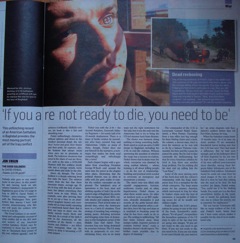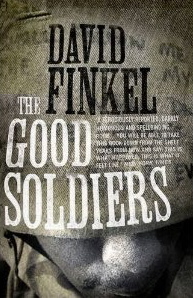Jon Swain - writer and foreign correspondent
Book review:
The Sunday Times, 25 April 2010

The Good Soldiers is an exceptional and unforgettable account of what conflict did to the 801 men and women of one American combat battalion. Finkel says he explained to them that his intent was to “document their corner of the war, without agenda”, and he achieves it brilliantly. Skilfully written, his book is also a fast and absorbing read.
Finkel unflinchingly chronicles, without opinion and down to the smallest personal detail, the soldiers’ horror and grief, their shame and their pride; he captures, also, the humour that always exists when men are in proximity to death. The ludicrous situations that occur in the chaos of war are there, too, such as the time a $150,000 Humvee with five soldiers inside rolls into a sewage trench, turns upside down and sinks in the shit.
Above all, though, The Good Soldiers is a deeply sobering book that stabs the heart. The sadness comes from the fact that these American troops, average age 19, are in Iraq with the best of intentions, but almost everything they touch turns to ruin. When, for example, soon after arriving they try to set up a base in an abandoned spaghetti factory and innocently tell an Iraqi family squatting in a mud-brick hovel there that it does not have to move out, the family naively trusts them and stays put. As a result of the faith it puts in the Americans, all the members of the family — men, women and children — are killed when insurgents blow up the factory to deny it becoming a US army outpost.
Finkel was with the 2-16 — the Second Battalion, Sixteenth Infantry Regiment — for nearly half of its 15-month deployment. There is a mass of books written by journalists who have covered Iraq and Afghanistan. Unlike so many of them, though, Finkel does not put himself in the narrative, a technique that makes his book read compellingly and refreshingly like a novel. Each chapter begins with a quotation from something President George W Bush said around the same time the action in the chapter takes place, illustrating that the political rhetoric was so often at odds with the grim reality of combat the soldiers encounter on the ground. The battalion’s area of operations is the heat, dust and stinking squalor of Sadr City on the eastern edge of Baghdad, the centre of the insurgency, where IEDs, suicide attacks and sniping were daily occurrences. Their arrival came at a pivotal time, when the Americans were in a Catch-22 situation. Their strategy of invading Iraq, winning a lasting peace, defeating terrorism and bringing some form of democracy to this benighted corner of the Middle East had failed. Post-invasion Iraq was being destroyed by sectarian violence. The US army, with its propensity to use overwhelming force, was in so many ways not the right instrument for the task, but it was the only tool the Americans had to try to bring the US-led mission back from disaster.
The choice was between doing nothing or doing something badly. Bush opted to send an extra 21,000 troops to Baghdad, including the 2-16, to end the violence. Without answering the question of whether the surge was a success or a failure, Finkel shows that in many ways the whole enterprise was damned by using combat infantry — whose training is all about killing people — to do the sort of relationship-building and practical work needed to overcome an insurgency and reconstruct a country.
The men’s tour was filled with squalid engagements, heroism, confusion, cruelty and, so often, hopelessness. Finkel shows us what these words mean. He takes an incident such as an IED explosion, clinically dismantles it and records all the gritty factual aftermath of what happens when a soldier dies, loses his legs and arms or is stretched to breaking point by what he has been made to do or see. The writing is unflinching: “All four limbs burned away, bony stumps visible. Superior portion of cranium burned away,” reads a battalion doctor’s death report. “No further exam possible due to degree of charring.”
The commander of the 2-16 is Lieutenant Colonel Ralph Kauzlarich, a West Pointer. Operating from a tiny office just big enough for three folding chairs and a desk, the colonel, a decent man, tried to trust his instincts as he was told to do by a famous Vietnam commander, his hero and the reason he joined the army. But he had to face constantly the disillusioning fact that for every American solution he tried in Iraq there was another Iraqi problem. Not for nothing did his men end up calling him the “Lost Kauz”.
Some of the most moving parts of the book deal with the colonel’s relationship with his Iraqi interpreter Izzy. It is a metaphor for the whole enterprise. The Iraqi wants peace for his country. America, which intervened in Iraq for what its leaders claim were the best of intentions, is incapable of delivering peace for all its wealth and military might. Finkel details the 2-16’s preparations for going to war at the start of the book. Kauzlarich’s catchphrase, “It’s all good”, encapsulates the boundless optimism of the US army in spite of the fact that they are going into danger. “If you are not ready to die, you need to get there. If you are not ready to die, you need to be. If you are not ready to see your friends die, you need to be,” an army chaplain told Kauzlarich’s soldiers before they left Fort Riley, Kansas, for Iraq.
When the battalion comes home 15 months later, 14 of its men are dead, another 75 are wounded. Kauzlarich leaves feeling sure that the 2-16 had won. They had made a difference. But he had seen enough, and as his helicopter lifted off from Baghdad for the last time he kept his eyes closed. A number of his men suffered post-traumatic stress disorder, among them Sergeant Adam Schumann, one of the battalion’s best soldiers. Schumann found he could not erase from his mind images of the war, such as that of a man he had shot sinking into the mud as he died. He had reached his limits, Finkel writes. “You could see it in his shaking hands. You could see it in the three prescription bottles in his room: one to steady his galloping heart rate, one to reduce his anxiety, one to minimise his nightmares.”
The war haunts Schumann still, like so many soldiers of the 2-16, and Finkel’s book, better than any I have come across, makes it possible for the rest of us to understand why.
pdf: The Good Soldiers
The Good Soldiers on Amazon.


